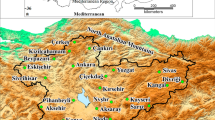Abstract
Climate change and its urban-induced bias in selected Turkish cities is studied with a quality controlled temperature and precipitation data of Turkish stations in the period of 1950–2004. These stations are classified into two groups according to their populations; S1, including rural and suburban stations and S2, including large urban stations. Moving average signals, 365-day, and their digital low pass filtered versions are produced to eliminate the short term fluctuations and examine the possible trends or anomalies in climate data. Furthermore, ‘relative difference’ signals are introduced and applied to temperature and precipitation series to observe the actual local changes in the climate data independent from large-scale effects. Mann–Kendall test statistics are calculated for maximum, minimum, mean temperature and precipitation series and plotted on maps to determine any spatial trend patterns. Signal analysis show a cool period extending from early 1960s till 1993, generally with the lowest temperature values on 1992–1993 owing to the eruption of Mount Pinatubo. A last decade significant warming trend is observed in both of the series, S1 and S2, leading to 2000–2002 temperatures to be recorded as maximums in record history. The variability of urban precipitation series is generally larger than the rural ones, suggesting that urban stations can experience more frequent and severe droughts and floods. Though not significant, an increase in the urban precipitation compared to the rural one is also found. Spatial analysis resulted in significant warming in southern and southeastern parts of the country. Particularly, minimum temperature series show significant warming in almost all of the regions indicating the effect of urbanization. Significant decreases of precipitation amounts in the western parts of Turkey, such as Aegean and Trachea regions, are found. On the other hand, some Turkish northern stations show increases in precipitation of which some are significant.
Similar content being viewed by others
References
Alpert P, Osetinsky I, Zivb B, Shafir H (2004) Semi-objective classification for daily synoptic systems: application to the Eastern Mediterranean climate change. Int J Climatol 24:1001–1011
Alpert P, Krichak SO, Osetinsky I, Dayan M, Haim D, Shafir H (2006) Climatic trends to extremes and regional modeling over the E. Mediterranean. In: Unal YS et al (eds) Int. conf. on climate change and the Middle East. Istanbul Technical University Turkey, November, pp 20–23
Charlson RJ, Wigley TML (1994) Sulfate aerosol and climatic change. Sci Am 270:48–57
Eshel G, Farrell BF (2000) Mechanisms of Eastern Mediterranean rainfall variability. J Atmos Sc 57(19):3219–3232
Ezber Y, Sen OL, Kindap T, Karaca M (2006) Climate effects of urbanization in İstanbul: a statistical and modeling analysis. Int J Climatol 26:1225–1236
IPCC (2001) Intergovernmental panel on climate change. Climate change 2001–the scientific basis: contribution of working group I to the third assessment report of the intergovernmental panel on climate change. In: Houghton JT et al (eds) Cambridge University Press, New York
Jones PD, Mann ME (2004) Climate over past millennia. Rev Geophys 42 RG2002. doi:10.1029/2003RG000143
Kahya E, Karabörk MC (2001) The analysis of el nino and la nina signals in streamflow of Turkey. Int J Climatol 21:1231–1250
Kalaycı S, Kahya E (2006) Assessment of streamflow variability modes in Turkey: 1964–1994. J Hydrol 324:163–177
Karabörk MC, Kahya E, Karaca M (2005) The influences of the Southern and North Atlantic oscillations on climate surface variables in Turkey. Hydrol Process 19:1185–1211
Karaca M, Tayanç M, Toros H (1995) The effects of urbanization on climate of İstanbul and Ankara. Atmos Environ (Urban Atmospheres) 29:3411–3421
Karaca M, Deniz A, Tayanç M (2000) Cyclone track variability over Turkey in association with regional climate. Int J Climatol 20:1225–1236
Karl TR et al (1993) Asymmetric trends of daily maximum and minimum temperature. Bull Amer Meteor Soc 74:1007–1023
Kiehl JT, Schneider TL, Rasch PJ, Barth MC, Wong J (2000) Radiative forcing due to sulfate aerosols from simulations with the national center for atmospheric research community climate model, Version 3. J Geophys Res 105:1441–1457
Krichak SO, Tsidulko M, Alpert P (2000) Monthly synoptic patterns associated with wet/dry conditions in the Eastern Mediterranean. Theor Appl Climatol 65:215–229
Minnis P, Harrison EF, Stowe LL, Gibson GG, Denn FM, Doelling DR, Smith WL Jr (1993) Radiative climate forcing by the Mount Pinatubo eruption. Science 259:1411–1415
Mitra SK (2001) Digital signal processing, 2nd edn. McGraw-Hill
Nasrallah HA, Balling RC (1993) Spatial and temporal analysis of Middle Eastern temperature changes. Clim Change 25:153–161
Onol B, Semazzi FHM, Unal YS, Dalfes HN (2006) Regional climatic impacts of global warming over the eastern Mediterranean. In: Unal YS et al (eds) Int. conf. on climate change and the Middle East. Istanbul Technical University Turkey, November, pp 20–23
Robock A (2000) Volcanic eruptions and climate. Rev Geophys 38:191–219
Soden BJ, Wetherald RT, Stenchikov GL, Robock A (2002) Global cooling after the eruption of Mount Pinatubo: a test of climate feedback by water vapor. Science 296:727–730
Tayanç M, Toros H (1997) Urbanization effects on regional climate change in the case of four large cities of Turkey. Clim Change 35:501–524
Tayanç M, Karaca M, Yenigün O (1997) Annual and seasonal air temperature trend patterns of climate change and urbanization effects in relation with air pollutants in Turkey. J Geophys Res No. D2 102:1909–1919
Tayanç M, Dalfes HN, Karaca M, Yenigün O (1998a) A comparative assessment of different methodologies for detecting inhomogeneities in Turkish temperature dataset. Int J Climatol 18:561–578
Tayanç M, Karaca M, Dalfes HN (1998b) March 1987 cyclone (blizzard) over the eastern Mediterranean and Balkan region associated with blocking. Mon Wea Rev 126:3036–3047
Wigley TML (2005) The climate change commitment. Science 1766–1769, 18 March
WMO (1992) Monitoring, assessment and combat of drought and desertification. WMO/TD-No.505 Geneva
Author information
Authors and Affiliations
Corresponding author
Rights and permissions
About this article
Cite this article
Tayanç, M., İm, U., Doğruel, M. et al. Climate change in Turkey for the last half century. Climatic Change 94, 483–502 (2009). https://doi.org/10.1007/s10584-008-9511-0
Received:
Accepted:
Published:
Issue Date:
DOI: https://doi.org/10.1007/s10584-008-9511-0




